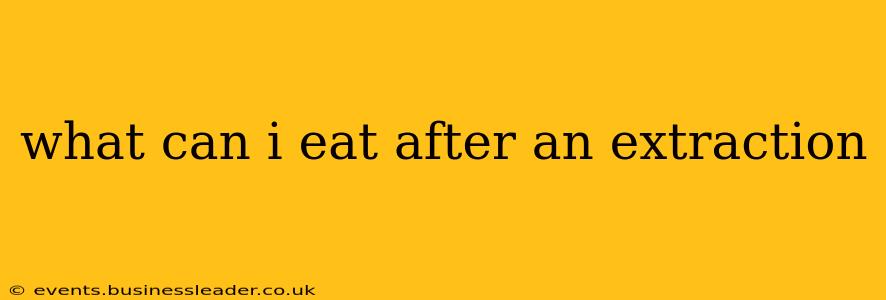What Can I Eat After an Extraction? A Guide to Post-Surgical Nutrition
Having a tooth extracted can be a bit unsettling, and knowing what to eat afterward is a key part of your recovery. The immediate period after the extraction is crucial for healing, and your diet plays a significant role. This guide will cover the best foods to eat and those to avoid, answering common questions many people have after this procedure.
What to Eat After a Tooth Extraction:
The first 24 hours are the most critical. You need soft foods that won't disrupt the blood clot forming in the extraction site. Think gentle, easily chewed options that won't irritate the wound.
-
Soft, Smooth Foods: The best bet is a blend of soft foods that are easy to swallow and won't require chewing. This includes:
- Yogurt (full-fat is ideal): Provides protein and calcium for healing.
- Applesauce: A classic choice, offering sweetness and nutrients without causing harm.
- Smoothies: Blend fruits, vegetables, and yogurt for a nutritious and easily consumed meal.
- Mashed Potatoes: Comfort food at its best, packed with carbohydrates for energy.
- Oatmeal: A warm and soothing option, easy on the gums.
- Scrambled eggs: A good source of protein, just make sure they're well-cooked and soft.
-
Nutritional Considerations: Focus on foods high in protein (for tissue repair) and vitamins (for overall healing).
What to Avoid After a Tooth Extraction:
The goal is to prevent anything from dislodging the blood clot or irritating the healing extraction site. Avoid these foods:
- Anything Hot: Hot liquids can increase bleeding and discomfort.
- Spicy Foods: These can irritate the sensitive gum tissue.
- Hard Foods: Anything requiring vigorous chewing (e.g., nuts, hard candies, chips) should be strictly avoided.
- Acidic Foods: Acidic foods like citrus fruits and tomatoes can irritate the wound.
- Foods that Require Sucking: Sucking can dislodge the blood clot. Avoid straws, lollipops, and hard candies.
- Alcohol and Tobacco: These impede healing and can increase the risk of infection.
What are some good foods to eat if I’m on a liquid diet after an extraction?
A liquid diet post-extraction is usually temporary, maybe only for the first day or so. The goal is to provide nourishment without disturbing the healing site. Examples of good liquid options include:
- Protein shakes: Essential for tissue repair.
- Broth: Warm, soothing, and provides hydration and electrolytes.
- Milkshakes: A nutritious and palatable option.
- Fruit juices (diluted): Choose options without added sugars.
What are some soft foods I can eat a few days after an extraction?
As you heal, you can gradually reintroduce slightly firmer foods. Good options include:
- Well-cooked pasta: Choose sauces that aren't too acidic or spicy.
- Soft-cooked vegetables: Steamed or pureed vegetables are less likely to cause irritation.
- Fish: Flaky white fish is a good source of protein and is easy to chew.
How long should I stick to a soft food diet after a tooth extraction?
The length of time you need a soft food diet depends on the complexity of the extraction and your individual healing rate. Typically, you can transition back to your normal diet after a week or two, but always follow your dentist's instructions.
Can I eat solid food right after a tooth extraction?
No, it's crucial to avoid solid foods for at least the first 24 hours, sometimes longer, to prevent disrupting the blood clot and slowing down the healing process. Starting with soft foods is vital.
Remember, your dentist or oral surgeon is the best source of information regarding your specific post-extraction dietary needs. Always follow their recommendations closely to ensure proper healing and minimize any complications. This information is for general guidance only and does not constitute medical advice.
